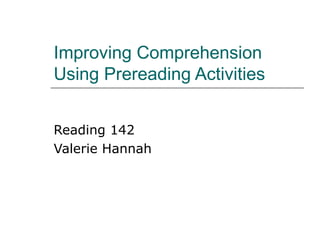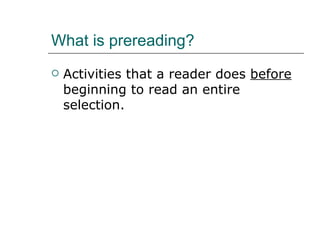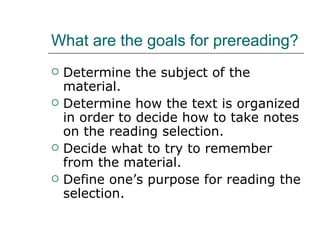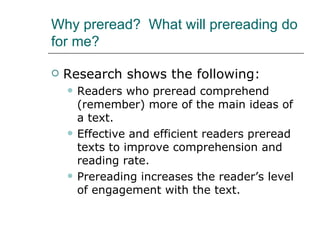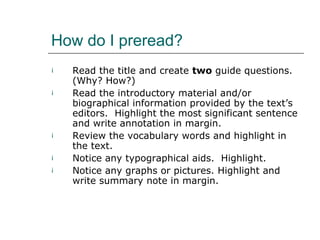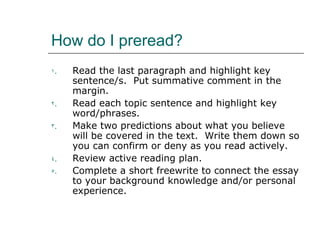Read 142 prereading power point
- 1. Improving Comprehension Using Prereading Activities Reading 142 Valerie Hannah
- 2. What is prereading? Activities that a reader does before beginning to read an entire selection.
- 3. What are the goals for prereading? Determine the subject of the material. Determine how the text is organized in order to decide how to take notes on the reading selection. Decide what to try to remember from the material. Define one’s purpose for reading the selection.
- 4. Why preread? What will prereading do for me? Research shows the following: Readers who preread comprehend (remember) more of the main ideas of a text. Effective and efficient readers preread texts to improve comprehension and reading rate. Prereading increases the reader’s level of engagement with the text.
- 5. Why preread? What will prereading do for me? Research shows the following: Prereading provides the opportunity for the reader to connect his/her personal experiences and/or background knowledge with the text’s subject thereby improving comprehension. Prereading helps the reader to follow the author’s train of thought more easily. Like a road map, it helps you figure out what lies ahead and how it is arranged.
- 6. Common Questions How long will this take? That depends on how long the essay is and how much scaffolding exists for the essay, but generally speaking, a reader can complete prereading activities in less than fifteen minutes.
- 7. Common Questions Is this worth my time? Will this really benefit me? Yes. If you preread materials consistently, this practice will become easy for you, and all the reading research shows that readers who preread are more actively engaged when they read. Because they are actively engaged, their comprehension improves and reading rates increase . In the end, prereading may actually save you time because you spend less time rereading. Another key benefit is that you are more likely to understand easily the main ideas put forth by the author.
- 8. How do I preread? Read the title and create two guide questions. (Why? How?) Read the introductory material and/or biographical information provided by the text’s editors. Highlight the most significant sentence and write annotation in margin. Review the vocabulary words and highlight in the text. Notice any typographical aids. Highlight. Notice any graphs or pictures. Highlight and write summary note in margin.
- 9. How do I preread? Review boldface headings and create one guide question per heading. Read the discussion questions that follow the essay to help determine your active reading plan . Write active reading plan in margins. Read the first paragraph and highlight key sentence/s. Put summative comment in the margin.
- 10. How do I preread? Read the last paragraph and highlight key sentence/s. Put summative comment in the margin. Read each topic sentence and highlight key word/phrases. Make two predictions about what you believe will be covered in the text. Write them down so you can confirm or deny as you read actively. Review active reading plan. Complete a short freewrite to connect the essay to your background knowledge and/or personal experience.

